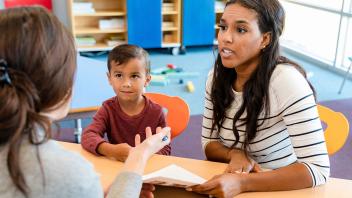Last week, I began a multi-part series on how I taught my daughters to read. My oldest daughter wryly replied to that entry, suggesting I could have saved a lot of pixels if I had just said that I hired a tutor…. And her son who just had his third birthday (and who did not read that entry) informed me that his goal for being three years old was to read words.
In that first entry, I described the literacy context in which my daughters grew up. Now, let’s turn to the more formal side of the teaching.
When the girls were two-to-three years old, more explicit teaching was introduced. Each child was encouraged to tell stories (often recounting personal experiences — I think this may have started with a family vacation). Essentially, these were language-experience approach stories. They would tell the story and I’d print them out in letters, two-lines high with plenty of space between words (initially on pieces of paper, and later in composition books — which they still have). I’d read the stories back to them, and they would choral read with me.
Over time, they came to recognize some of the words in their stories. This was less direct teaching (I did not set out to teach particular words), but I was just responsive to what they were picking up. If they seemed to remember a particular word, I’d add it to an index card (yes, a flash card); if they forgot it at some point, that word would disappear from the pack.
The point was to build a collection of words that they would recognize at sight. Like most children, they were fascinated by words like mommy, daddy, grandma, grandpa, as well as their names and their sister’s name. They each managed to develop a sight vocabulary of approximately 25 words — words they could recognize out of context — before they could actually read.
This facet of what I did probably accomplished several goals beyond getting some written words into their memories:
(1) it would have developed an understanding of print awareness (including directionality, the idea that letters are used to write words, the concept of word — the idea that words are separable);
(2) it would have further sensitized them to the relationship between language and reading (since they saw language being recorded and read back);
(3) it would have started to sensitize them to the idea of the permanence of literacy, that we could read back the words and that they didn’t change over time;
(4) it may have provided them with some baseline insights into sound-symbol relationships (as I would repeat their words as I wrote them) — however, I don’t think it was particularly powerful in this regard and I did not stress that.
Thus, we built an early base of both word knowledge and print awareness.
Authorities argue over whether you should start with words or letters and sounds. My reading is that here is no convincing evidence on either side; research seems to show that both approaches work and that they do not need to be mutually exclusive.
In our case, the whole time we were meeting the goals listed above, we were also explicitly teaching letters and sounds, and later spelling patterns. Thus, when they were telling these language experience stories, they were also memorizing their letters and learning the letter sounds.
The same thing is currently going on with my grandson. He is currently learning some words, but he already knows all of the letters — lower case and upper case, and the simple sounds that go with all or most of the consonants. He isn’t decoding yet, but he is gaining the raw materials needed to do that well.
We did many language experience stories and this soon morphed into the kids doing their own writing — they could both “write” before they could read. But let me add one additional “print awareness” activity that we found beneficial.
I have already described the extensive shared reading that we did with our girls. Remember, I was a young professor at the time, still learning lots about my craft. One day I was reading some research studies by Ferreiro & Teberosky. They described how the children they were studying had to learn that the words on the page told the story (the kids thought their parents made up the stories based on the pictures). I’d never noticed that confusion before — whether it had been there or not — but I brought this one home right away.
That evening when I was reading to E., she put her hand on the page as young children do. Usually I would have just moved it away and kept reading, but this time I stopped in my tracks. “What’s wrong?” she asked.
“You’ve covered the words, so I can’t read them.”
“You read that?”
“Yes.”
She was amazed and the rest of that reading was spent with her trying to interfere with it by anticipating where my eyes were going to be looking. Despite having the benefit of outstanding parents, she had no idea what to look at during reading before this. Not surprisingly, I introduced M. to this little game earlier than I had done with her sister.
Japanese scholars have long believed that when parents point at the text that they read to their children, that they are teaching important aspects of print awareness. You don’t always have to print at what you read, but it is a good idea to do that some of the time.
See the three related posts here:

